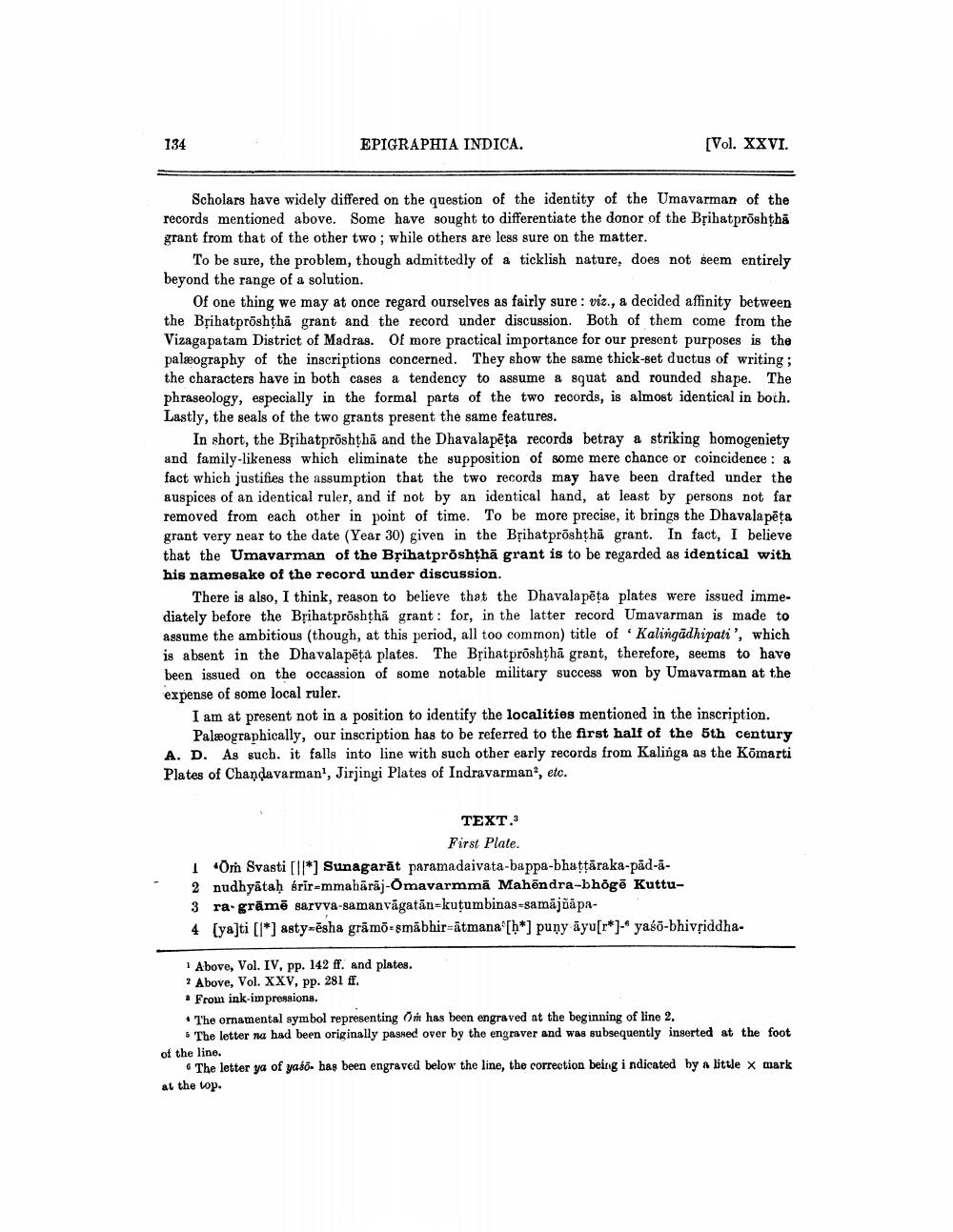________________
134
EPIGRAPHIA INDICA.
[Vol. XXVI.
Scholars have widely differed on the question of the identity of the Umavarman of the records mentioned above. Some have sought to differentiate the donor of the Bțihatproshtha grant from that of the other two; while others are less sure on the matter.
To be sure, the problem, though admittedly of a ticklish nature, does not seem entirely beyond the range of a solution.
Of one thing we may at once regard ourselves as fairly sure: viz., a decided affinity between the Bțihatproshtha grant and the record under discussion. Both of them come from the Vizagapatam District of Madras. Of more practical importance for our present purposes is the palæography of the inscriptions concerned. They show the same thick-set ductus of writing; the characters have in both cases a tendency to assume a squat and rounded shape. The phraseology, especially in the formal parts of the two records, is almost identical in both. Lastly, the seals of the two grants present the same features.
In short, the Bțihatproshthā and the Dhavalapēta records betray a striking homogeniety and family-likeness which eliminate the supposition of some mere chance or coincidence : a fact which justifies the assumption that the two records may have been drafted under the auspices of an identical ruler, and if not by an identical hand, at least by persons not far removed from each other in point of time. To be more precise, it brings the Dhavalapēta grant very near to the date (Year 30) given in the Bțihatproshthā grant. In fact, I believe that the Umavarman of the Bșihatproshthā grant is to be regarded as identical with his namesake of the record under discussion.
There is also, I think, reason to believe that the Dhavalapēța plates were issued immediately before the Bșihatpröshtha grant: for, in the latter record Umavarman is made to assume the ambitious (though, at this period, all too common) title of Kalingādhipati', which is absent in the Dhavalapēta plates. The Bțihatproshthā grant, therefore, seems to have been issued on the occassion of some notable military success won by Umavarman at the expense of some local ruler.
I am at present not in a position to identify the localities mentioned in the inscription.
Palæographically, our inscription has to be referred to the first half of the 5th century A. D. As such, it falls into line with such other early records from Kalinga as the Kōmarti Plates of Chandavarman', Jirjingi Plates of Indravarman', etc.
TEXT.3
First Plate. | Örn Svasti [*] Sunagarāt paramadaivata-bappa-bhattāraka-păd-a2 nudhyātaḥ srir-mmahārāj-Omavarmmā Mahēndra-bhögë Kuttu3 ra grāmē sarvva-samanvāgatān=kutumbinas-samājõapa4 (yalti [l*) asty-ěsha grāmõ=smābhir=ātmana [h*] puny ayu[r*]- yaső-bhivsiddha
1 Above, Vol. IV, pp. 142 ff. and plates. 2 Above, Vol. XXV, pp. 281 ff. * From ink-impressions. • The ornamental symbol representing Om has been engraved at the beginning of line 2.
5 The letter na had been originally passed over by the engraver and was subsequently inserted at the foot of the line.
The letter ya of yaso- has been engraved below the line, the correction being i ndicated by a little x mark at the top.




